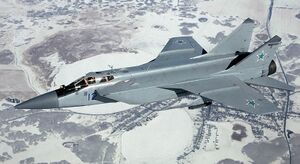AFSF-10 Orso Strike Fighter: Difference between revisions
mNo edit summary |
mNo edit summary |
||
| Line 90: | Line 90: | ||
[[Category:Cacerta]] | [[Category:Cacerta]] | ||
[[Category:Cacertian Aircraft]] | |||
[[Category:Military of Cacerta]] | [[Category:Military of Cacerta]] | ||
[[Category:Cacertian Royal Air Fleet]] | [[Category:Cacertian Royal Air Fleet]] | ||
Revision as of 18:44, 30 April 2021
| Casati AFSF-10 Orso | |
|---|---|

| |
| An Orso during a joint military exercise in Syara. | |
| Role | Interceptor aircraft |
| National origin | |
| Manufacturer | Casati Aircraft Corporation |
| First flight | 10 April 1978 |
| Introduction | 7 June 1984 |
| Status | In active service |
| Primary user | |
| Produced | 1984—2003 |
| Number built | 455 |
| Unit cost |
ɫ31,502,000
|
The Casati AFSF-10 Orso (Bear) is a twin-engine, all-weather, supersonic interceptor aircraft designed by Casati Aircraft Corporation and introduced to the Royal Air Fleet in 1984. It was built as a deterrent for recently developed long-range high speed bombers and reconnaissance aircraft. Although they are nearly three decades old, the Orso still maintains the characterization of being one of the Royal Air Fleet’s fastest aircraft and are expected to remain in service until at least 2040.
Despite its technical designation as a strike fighter (AFSF), the Orso does not fall under the same category.
Development
Characterized by being wide-spread and unable to properly respond to high-altitude or high-speed threats of the modern era, the CRAF went on to request various design corporations to develop a new type of fighter. When Casati constructed their first prototype, the I-10 in 1973 it severely lacked maneuverability at the required interception speeds and was excessively difficult to fly at low altitudes. However, despite the I-10’s initial drawbacks, it served as a proof of concept for Casati which spent the next five years improving on the design.
A breakthrough was made in 1976 with the creation of the company’s new Cas-AFSF10-84 afterburning turbofans which were capable of a maximum thrust of 103 kN. Several attempts to construct a stable airframe ended in disastrous failures until a prototype was finally completed in 1978. The I-10 Mark II made its first flight on 16 September 1978; at the time it was nothing more than a fuselage with basic controls and engines. The body was later modified and elongated to accommodate a new advanced radar capable of both look-up and look-down/shootdown engagements. This would allow the Royal Air Fleet the ability to engage all manner of hostile intruders at long range. The Orso began production in 1984.
Upgrades
The Orso fleet has undergone several upgrade programs since their introduction which has gone on to vastly improve the Orso’s avionics, upgraded it to a new multimode radar, hands-on-throttle-and-stick controls, and LCD displays. Although there has been ongoing rumors regarding the development of a replacement, there is currently no active program to replace the Orso and it is expected to remain in service through 2040.
Design
The AFSF-10 is a large, twin-engine aircraft with side-mounted air intake ramps, shoulder mounted wings, and a pair of vertical tailfins. It possesses two seats for a pilot and dedicated weapon systems officer. As its mission is entirely dedicated to high-speed and long-range interdiction, the Orso is ill-suited for close combat and rapid turning.
The wings and airframe of the Orso are known for being some of the strongest ever produced for Cacertian aircraft, permitting it to achieve supersonic flight at low altitudes. Since the aircraft’s flight surfaces were constructed using nickel-steel alloy, kinetic heating a Mach 3 is a non-factor. The 10-84 engines are rated for 152kN of thrust.
The AFSF-10 is characterized for being the Kingdom’s first operational fighter equipped with a passive electronically scanned array radar and is one of only a handful of aircraft in the world capable of firing long-range missiles independently. Possessing a maximum range of 225 kilometers, the Orso has the capability of tracking up to ten fighter-sized targets and simultaneously engage up to four of them with its armament.
As an interceptor, the AFSF-10's main armament consists of a variety of air-to-air missiles carried under the belly of the aircraft. It carries an internal, six barrel, 25 mm cannon that is mounted above the starboard landing gear bay.
Production
As a special role fighter, the AFSF-10s never entered full-scale production and were produced in limited numbers since their introduction. They have only been issued in handfuls to every CRAF base and require special training to handle and operate.
Production Figures
A total of 455 AFSF-10s have been completed since they entered service in 1984.
Operational History
The AFSF-10 has been constantly deployed on patrols around Cacerta's Home Islands and the Andria Military Protectorate. It saw its first deployments as high-speed, high altitude reconnaissance aircraft during the FedCom Civil War. It was later used in a similar fashion during the Nalayan Civil War.
Although the Orso has been in service since 1984, it has never needed to fire its weapons at any suspected or intruding aircraft.
Specifications
General Characteristics
- Crew: 2 (pilot and weapons systems officer)
- Length: 22.7 m (74 ft 5 in)
- Wingspan: 13.5 m (44 ft 2 in)
- Height: 6.2 m (20 ft 2 in)
- Wing Area: 61.6 m² (663 ft²)
- Empty Weight: 21,820 kg (48,100 lbs)
- Loaded Weight: 41,000 kg (90,400 lbs)
- Max Takeoff Weight: 46,200 kg (101,900 lbs)
- Powerplant: 2 × Cas-AFSF10-84 Turbofans
- Fuel Capacity: 11,400 kg (25,130 lbs)
Performance
- Maximum Speed: Mach 2.83 (3,000 km/h, 1,860 mph) at altitude
- Cruise Speed: 2,000 km/h (1,243 mph)
- Service Ceiling: 20,600 m (67,600 ft)
- Rate of Climb: 208 m/s (41,000 ft/min)
- Wing Loading: 665 kg/m² (136 lb/ft²)
- Thrust/Weight: 0.85
Armament
- Guns: 1 × 25 mm cannon with 800 rounds
- Payload: 9,500 kg (20,940 lb) on 14 external hardpoints (2 underwing, 12 underbelly)


